Role Strain and Burnout in Nursing: Issues, Effects, Solutions
VerifiedAdded on 2023/05/28
|7
|1319
|288
Essay
AI Summary
This essay delves into the pervasive issues of role strain and burnout within the nursing profession, highlighting their detrimental effects on nurses' physiological, psychological, and emotional well-being. It examines the implications of burnout on patient care, including increased medical errors and compromised quality of treatment, further exploring the associated ethical and legal concerns related to workplace safety and patient rights. The essay also identifies key factors contributing to nursing burnout, such as long working hours and workplace stress, and proposes strategies for mitigation, emphasizing the importance of self-care, stress management, and emotional support. The author shares personal experiences of strain and burnout, attributing them to staffing shortages, inability to provide optimal patient care, and limited opportunities for professional advancement. This document is available on Desklib, a platform offering a wide range of academic resources for students.
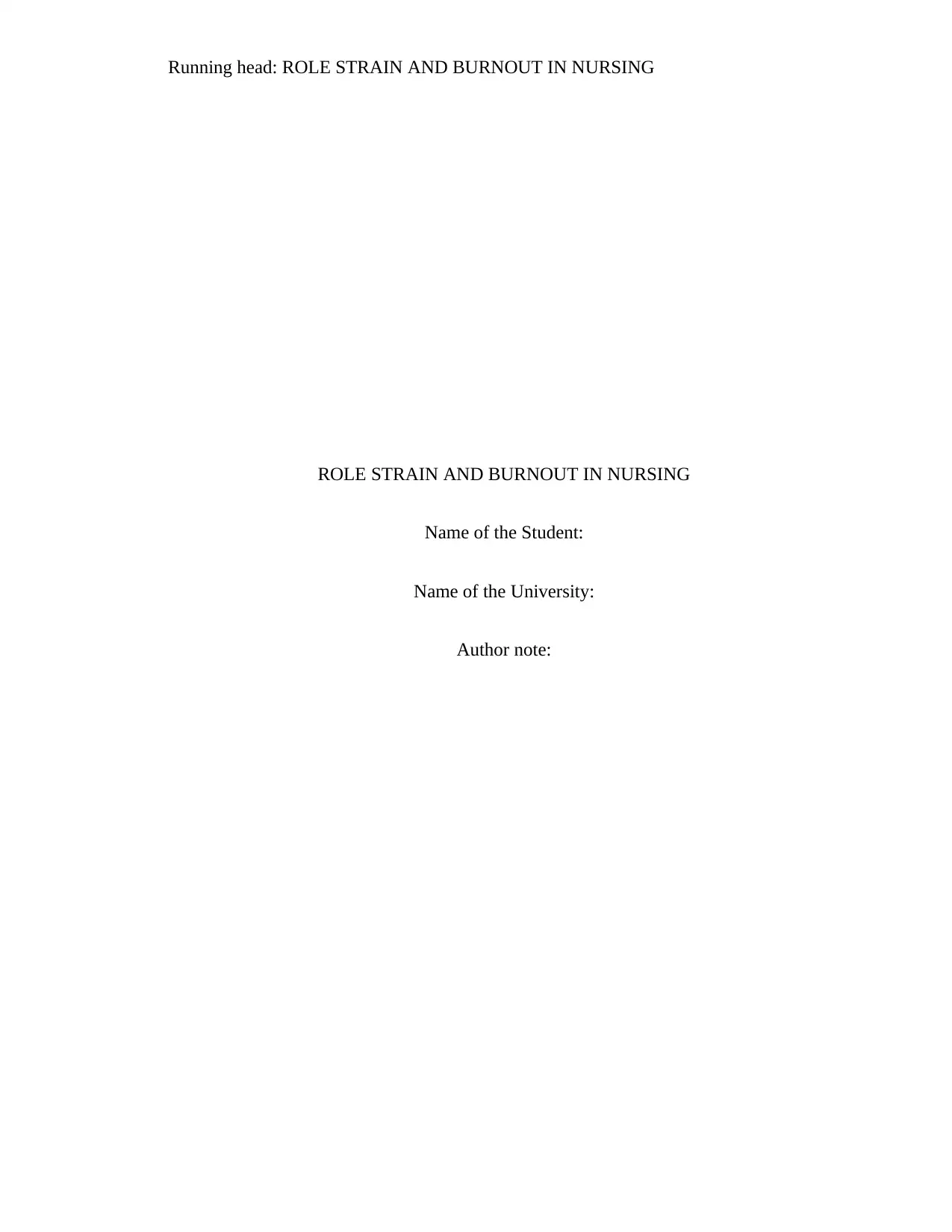
Running head: ROLE STRAIN AND BURNOUT IN NURSING
ROLE STRAIN AND BURNOUT IN NURSING
Name of the Student:
Name of the University:
Author note:
ROLE STRAIN AND BURNOUT IN NURSING
Name of the Student:
Name of the University:
Author note:
Paraphrase This Document
Need a fresh take? Get an instant paraphrase of this document with our AI Paraphraser
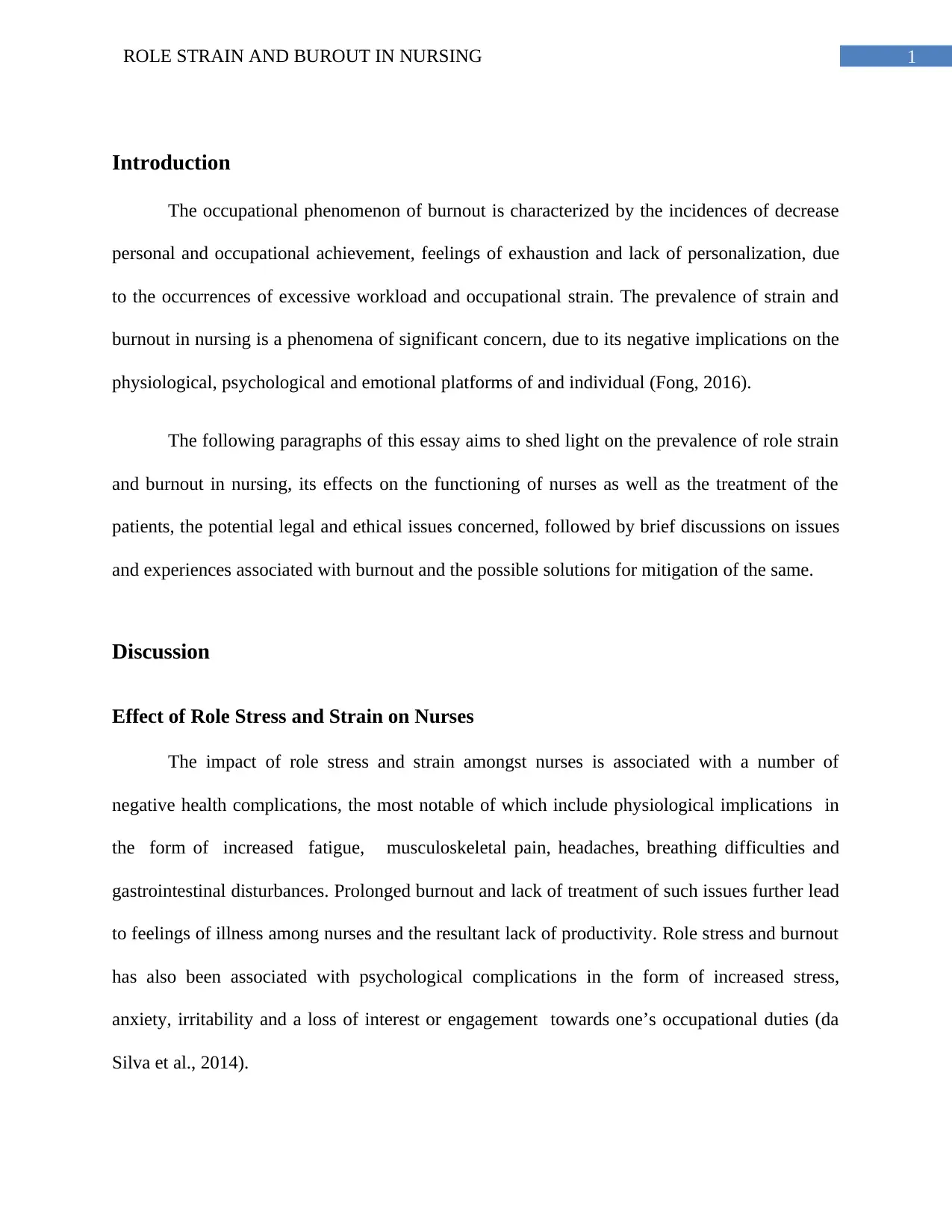
1ROLE STRAIN AND BUROUT IN NURSING
Introduction
The occupational phenomenon of burnout is characterized by the incidences of decrease
personal and occupational achievement, feelings of exhaustion and lack of personalization, due
to the occurrences of excessive workload and occupational strain. The prevalence of strain and
burnout in nursing is a phenomena of significant concern, due to its negative implications on the
physiological, psychological and emotional platforms of and individual (Fong, 2016).
The following paragraphs of this essay aims to shed light on the prevalence of role strain
and burnout in nursing, its effects on the functioning of nurses as well as the treatment of the
patients, the potential legal and ethical issues concerned, followed by brief discussions on issues
and experiences associated with burnout and the possible solutions for mitigation of the same.
Discussion
Effect of Role Stress and Strain on Nurses
The impact of role stress and strain amongst nurses is associated with a number of
negative health complications, the most notable of which include physiological implications in
the form of increased fatigue, musculoskeletal pain, headaches, breathing difficulties and
gastrointestinal disturbances. Prolonged burnout and lack of treatment of such issues further lead
to feelings of illness among nurses and the resultant lack of productivity. Role stress and burnout
has also been associated with psychological complications in the form of increased stress,
anxiety, irritability and a loss of interest or engagement towards one’s occupational duties (da
Silva et al., 2014).
Introduction
The occupational phenomenon of burnout is characterized by the incidences of decrease
personal and occupational achievement, feelings of exhaustion and lack of personalization, due
to the occurrences of excessive workload and occupational strain. The prevalence of strain and
burnout in nursing is a phenomena of significant concern, due to its negative implications on the
physiological, psychological and emotional platforms of and individual (Fong, 2016).
The following paragraphs of this essay aims to shed light on the prevalence of role strain
and burnout in nursing, its effects on the functioning of nurses as well as the treatment of the
patients, the potential legal and ethical issues concerned, followed by brief discussions on issues
and experiences associated with burnout and the possible solutions for mitigation of the same.
Discussion
Effect of Role Stress and Strain on Nurses
The impact of role stress and strain amongst nurses is associated with a number of
negative health complications, the most notable of which include physiological implications in
the form of increased fatigue, musculoskeletal pain, headaches, breathing difficulties and
gastrointestinal disturbances. Prolonged burnout and lack of treatment of such issues further lead
to feelings of illness among nurses and the resultant lack of productivity. Role stress and burnout
has also been associated with psychological complications in the form of increased stress,
anxiety, irritability and a loss of interest or engagement towards one’s occupational duties (da
Silva et al., 2014).
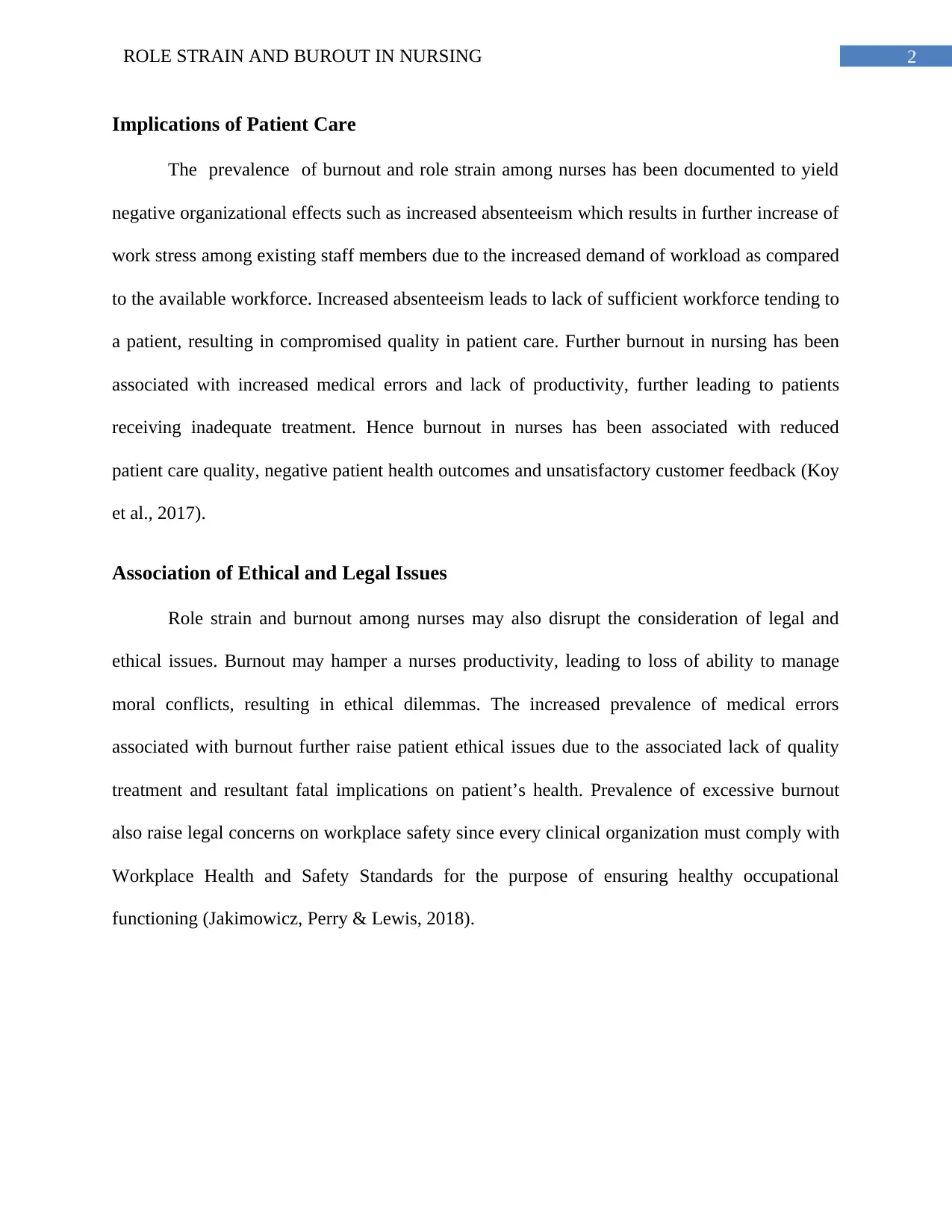
2ROLE STRAIN AND BUROUT IN NURSING
Implications of Patient Care
The prevalence of burnout and role strain among nurses has been documented to yield
negative organizational effects such as increased absenteeism which results in further increase of
work stress among existing staff members due to the increased demand of workload as compared
to the available workforce. Increased absenteeism leads to lack of sufficient workforce tending to
a patient, resulting in compromised quality in patient care. Further burnout in nursing has been
associated with increased medical errors and lack of productivity, further leading to patients
receiving inadequate treatment. Hence burnout in nurses has been associated with reduced
patient care quality, negative patient health outcomes and unsatisfactory customer feedback (Koy
et al., 2017).
Association of Ethical and Legal Issues
Role strain and burnout among nurses may also disrupt the consideration of legal and
ethical issues. Burnout may hamper a nurses productivity, leading to loss of ability to manage
moral conflicts, resulting in ethical dilemmas. The increased prevalence of medical errors
associated with burnout further raise patient ethical issues due to the associated lack of quality
treatment and resultant fatal implications on patient’s health. Prevalence of excessive burnout
also raise legal concerns on workplace safety since every clinical organization must comply with
Workplace Health and Safety Standards for the purpose of ensuring healthy occupational
functioning (Jakimowicz, Perry & Lewis, 2018).
Implications of Patient Care
The prevalence of burnout and role strain among nurses has been documented to yield
negative organizational effects such as increased absenteeism which results in further increase of
work stress among existing staff members due to the increased demand of workload as compared
to the available workforce. Increased absenteeism leads to lack of sufficient workforce tending to
a patient, resulting in compromised quality in patient care. Further burnout in nursing has been
associated with increased medical errors and lack of productivity, further leading to patients
receiving inadequate treatment. Hence burnout in nurses has been associated with reduced
patient care quality, negative patient health outcomes and unsatisfactory customer feedback (Koy
et al., 2017).
Association of Ethical and Legal Issues
Role strain and burnout among nurses may also disrupt the consideration of legal and
ethical issues. Burnout may hamper a nurses productivity, leading to loss of ability to manage
moral conflicts, resulting in ethical dilemmas. The increased prevalence of medical errors
associated with burnout further raise patient ethical issues due to the associated lack of quality
treatment and resultant fatal implications on patient’s health. Prevalence of excessive burnout
also raise legal concerns on workplace safety since every clinical organization must comply with
Workplace Health and Safety Standards for the purpose of ensuring healthy occupational
functioning (Jakimowicz, Perry & Lewis, 2018).
⊘ This is a preview!⊘
Do you want full access?
Subscribe today to unlock all pages.

Trusted by 1+ million students worldwide
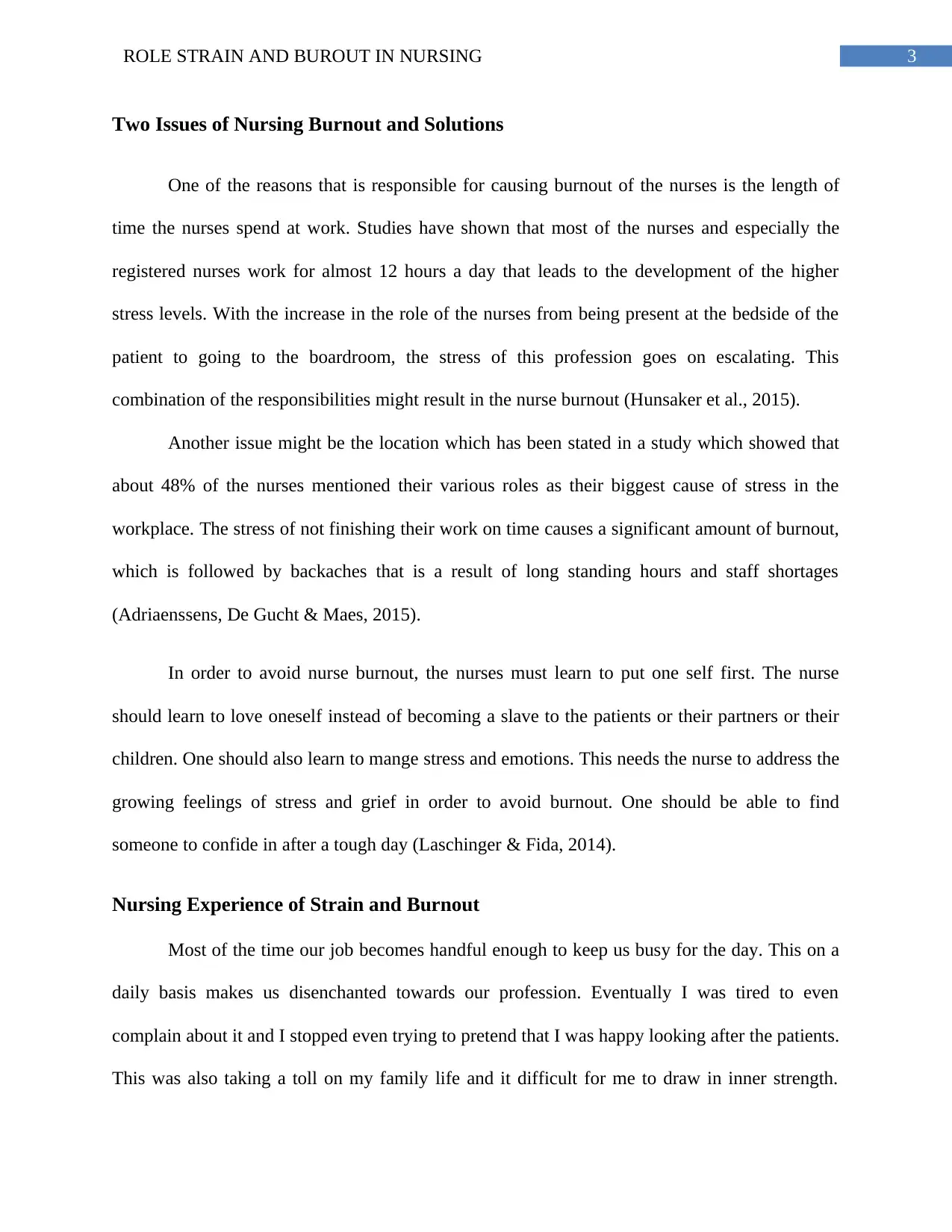
3ROLE STRAIN AND BUROUT IN NURSING
Two Issues of Nursing Burnout and Solutions
One of the reasons that is responsible for causing burnout of the nurses is the length of
time the nurses spend at work. Studies have shown that most of the nurses and especially the
registered nurses work for almost 12 hours a day that leads to the development of the higher
stress levels. With the increase in the role of the nurses from being present at the bedside of the
patient to going to the boardroom, the stress of this profession goes on escalating. This
combination of the responsibilities might result in the nurse burnout (Hunsaker et al., 2015).
Another issue might be the location which has been stated in a study which showed that
about 48% of the nurses mentioned their various roles as their biggest cause of stress in the
workplace. The stress of not finishing their work on time causes a significant amount of burnout,
which is followed by backaches that is a result of long standing hours and staff shortages
(Adriaenssens, De Gucht & Maes, 2015).
In order to avoid nurse burnout, the nurses must learn to put one self first. The nurse
should learn to love oneself instead of becoming a slave to the patients or their partners or their
children. One should also learn to mange stress and emotions. This needs the nurse to address the
growing feelings of stress and grief in order to avoid burnout. One should be able to find
someone to confide in after a tough day (Laschinger & Fida, 2014).
Nursing Experience of Strain and Burnout
Most of the time our job becomes handful enough to keep us busy for the day. This on a
daily basis makes us disenchanted towards our profession. Eventually I was tired to even
complain about it and I stopped even trying to pretend that I was happy looking after the patients.
This was also taking a toll on my family life and it difficult for me to draw in inner strength.
Two Issues of Nursing Burnout and Solutions
One of the reasons that is responsible for causing burnout of the nurses is the length of
time the nurses spend at work. Studies have shown that most of the nurses and especially the
registered nurses work for almost 12 hours a day that leads to the development of the higher
stress levels. With the increase in the role of the nurses from being present at the bedside of the
patient to going to the boardroom, the stress of this profession goes on escalating. This
combination of the responsibilities might result in the nurse burnout (Hunsaker et al., 2015).
Another issue might be the location which has been stated in a study which showed that
about 48% of the nurses mentioned their various roles as their biggest cause of stress in the
workplace. The stress of not finishing their work on time causes a significant amount of burnout,
which is followed by backaches that is a result of long standing hours and staff shortages
(Adriaenssens, De Gucht & Maes, 2015).
In order to avoid nurse burnout, the nurses must learn to put one self first. The nurse
should learn to love oneself instead of becoming a slave to the patients or their partners or their
children. One should also learn to mange stress and emotions. This needs the nurse to address the
growing feelings of stress and grief in order to avoid burnout. One should be able to find
someone to confide in after a tough day (Laschinger & Fida, 2014).
Nursing Experience of Strain and Burnout
Most of the time our job becomes handful enough to keep us busy for the day. This on a
daily basis makes us disenchanted towards our profession. Eventually I was tired to even
complain about it and I stopped even trying to pretend that I was happy looking after the patients.
This was also taking a toll on my family life and it difficult for me to draw in inner strength.
Paraphrase This Document
Need a fresh take? Get an instant paraphrase of this document with our AI Paraphraser
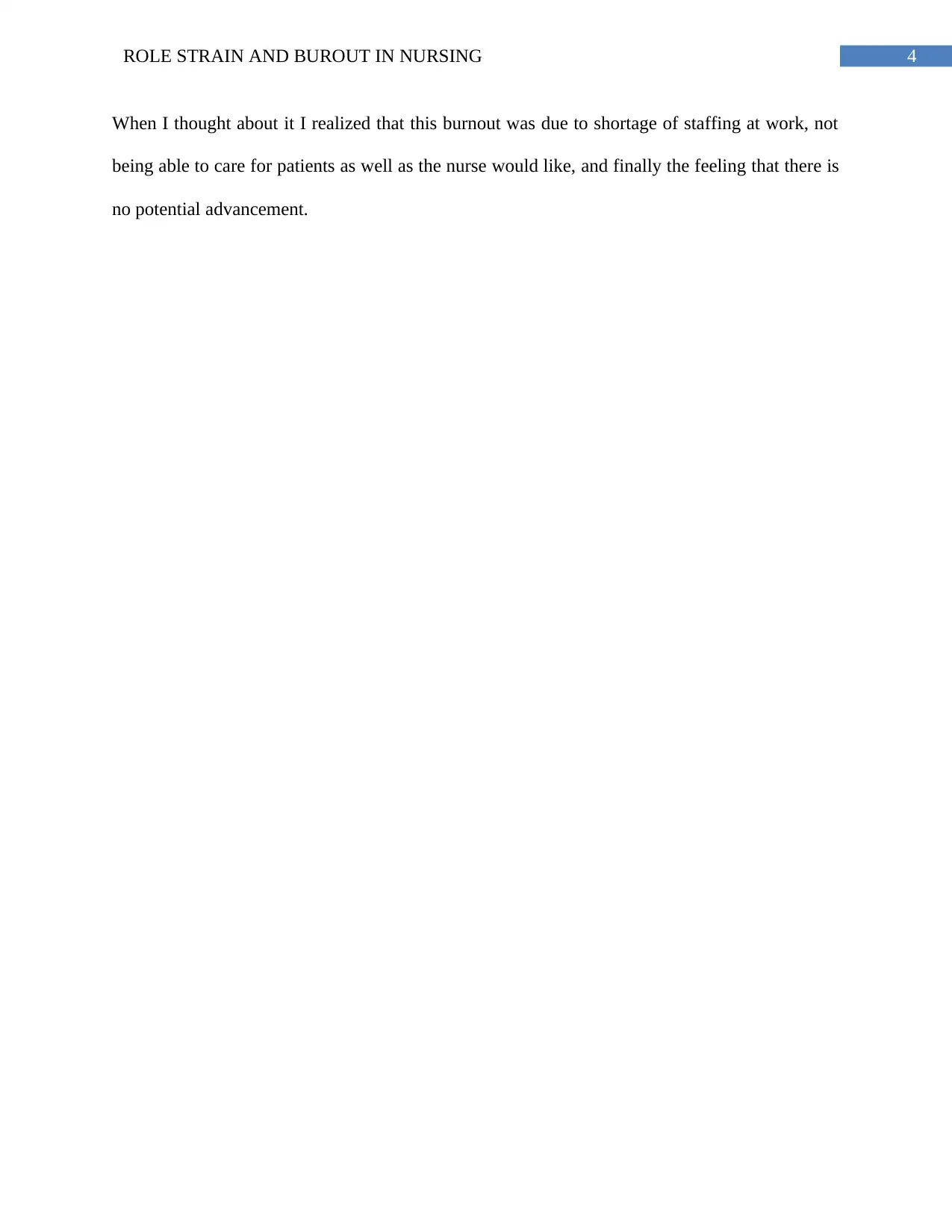
4ROLE STRAIN AND BUROUT IN NURSING
When I thought about it I realized that this burnout was due to shortage of staffing at work, not
being able to care for patients as well as the nurse would like, and finally the feeling that there is
no potential advancement.
When I thought about it I realized that this burnout was due to shortage of staffing at work, not
being able to care for patients as well as the nurse would like, and finally the feeling that there is
no potential advancement.
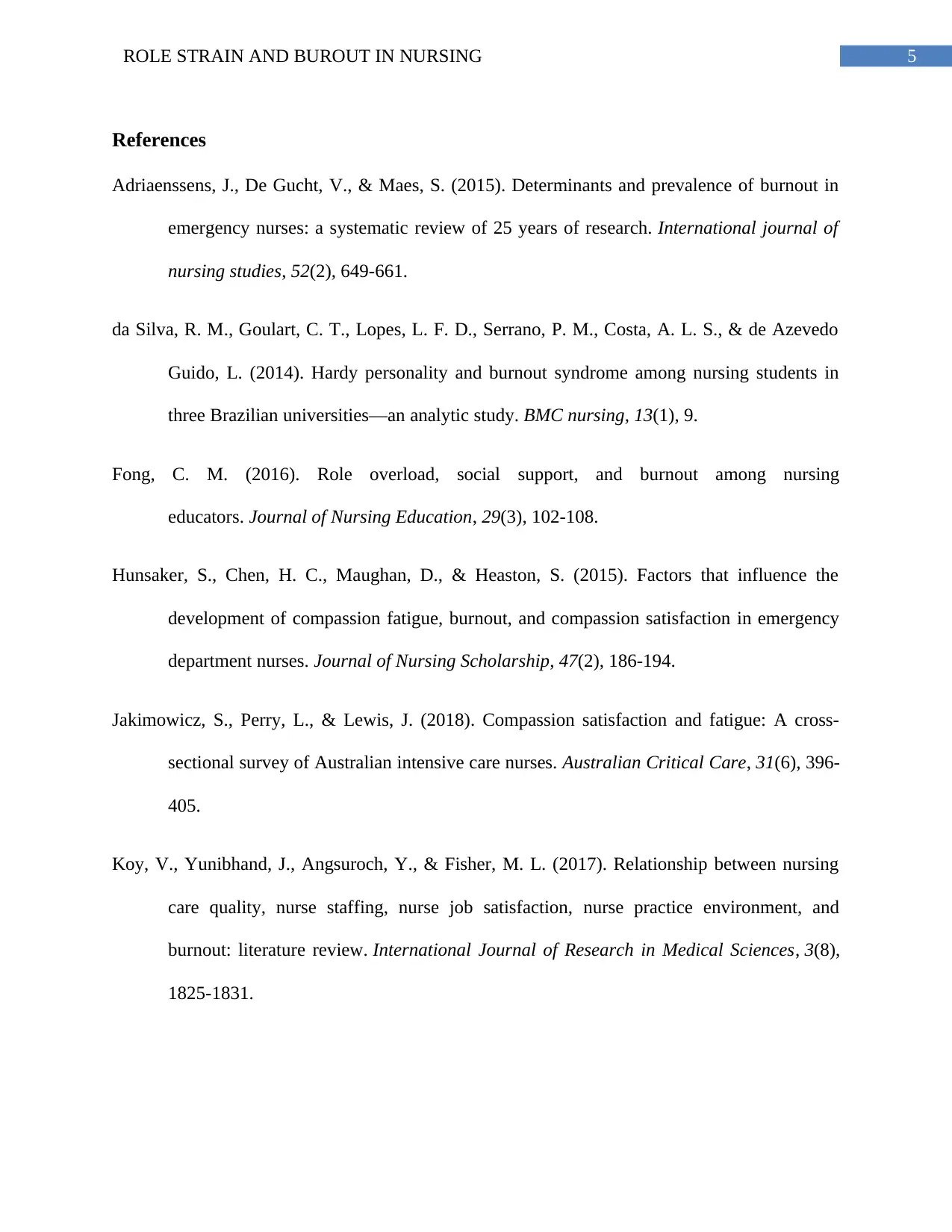
5ROLE STRAIN AND BUROUT IN NURSING
References
Adriaenssens, J., De Gucht, V., & Maes, S. (2015). Determinants and prevalence of burnout in
emergency nurses: a systematic review of 25 years of research. International journal of
nursing studies, 52(2), 649-661.
da Silva, R. M., Goulart, C. T., Lopes, L. F. D., Serrano, P. M., Costa, A. L. S., & de Azevedo
Guido, L. (2014). Hardy personality and burnout syndrome among nursing students in
three Brazilian universities—an analytic study. BMC nursing, 13(1), 9.
Fong, C. M. (2016). Role overload, social support, and burnout among nursing
educators. Journal of Nursing Education, 29(3), 102-108.
Hunsaker, S., Chen, H. C., Maughan, D., & Heaston, S. (2015). Factors that influence the
development of compassion fatigue, burnout, and compassion satisfaction in emergency
department nurses. Journal of Nursing Scholarship, 47(2), 186-194.
Jakimowicz, S., Perry, L., & Lewis, J. (2018). Compassion satisfaction and fatigue: A cross-
sectional survey of Australian intensive care nurses. Australian Critical Care, 31(6), 396-
405.
Koy, V., Yunibhand, J., Angsuroch, Y., & Fisher, M. L. (2017). Relationship between nursing
care quality, nurse staffing, nurse job satisfaction, nurse practice environment, and
burnout: literature review. International Journal of Research in Medical Sciences, 3(8),
1825-1831.
References
Adriaenssens, J., De Gucht, V., & Maes, S. (2015). Determinants and prevalence of burnout in
emergency nurses: a systematic review of 25 years of research. International journal of
nursing studies, 52(2), 649-661.
da Silva, R. M., Goulart, C. T., Lopes, L. F. D., Serrano, P. M., Costa, A. L. S., & de Azevedo
Guido, L. (2014). Hardy personality and burnout syndrome among nursing students in
three Brazilian universities—an analytic study. BMC nursing, 13(1), 9.
Fong, C. M. (2016). Role overload, social support, and burnout among nursing
educators. Journal of Nursing Education, 29(3), 102-108.
Hunsaker, S., Chen, H. C., Maughan, D., & Heaston, S. (2015). Factors that influence the
development of compassion fatigue, burnout, and compassion satisfaction in emergency
department nurses. Journal of Nursing Scholarship, 47(2), 186-194.
Jakimowicz, S., Perry, L., & Lewis, J. (2018). Compassion satisfaction and fatigue: A cross-
sectional survey of Australian intensive care nurses. Australian Critical Care, 31(6), 396-
405.
Koy, V., Yunibhand, J., Angsuroch, Y., & Fisher, M. L. (2017). Relationship between nursing
care quality, nurse staffing, nurse job satisfaction, nurse practice environment, and
burnout: literature review. International Journal of Research in Medical Sciences, 3(8),
1825-1831.
⊘ This is a preview!⊘
Do you want full access?
Subscribe today to unlock all pages.

Trusted by 1+ million students worldwide
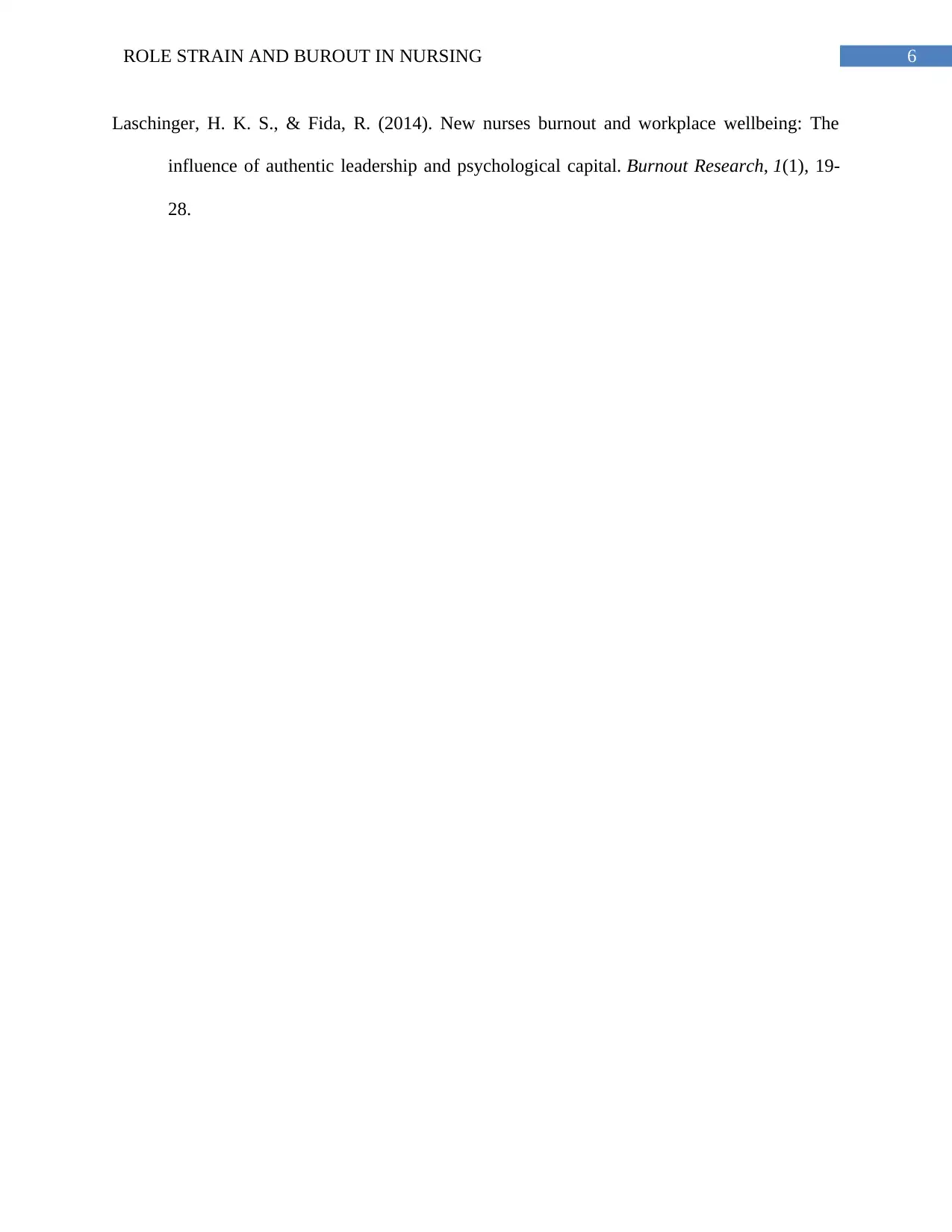
6ROLE STRAIN AND BUROUT IN NURSING
Laschinger, H. K. S., & Fida, R. (2014). New nurses burnout and workplace wellbeing: The
influence of authentic leadership and psychological capital. Burnout Research, 1(1), 19-
28.
Laschinger, H. K. S., & Fida, R. (2014). New nurses burnout and workplace wellbeing: The
influence of authentic leadership and psychological capital. Burnout Research, 1(1), 19-
28.
1 out of 7
Related Documents
Your All-in-One AI-Powered Toolkit for Academic Success.
+13062052269
info@desklib.com
Available 24*7 on WhatsApp / Email
![[object Object]](/_next/static/media/star-bottom.7253800d.svg)
Unlock your academic potential
Copyright © 2020–2025 A2Z Services. All Rights Reserved. Developed and managed by ZUCOL.





